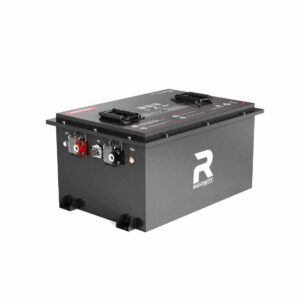What Makes the 48V 100Ah Peak 315A Battery Ideal for High-Performance Applications?
The 48V 100Ah Peak 315A battery is a lithium iron phosphate (LiFePO4) power solution designed for high-demand applications like solar energy storage, electric vehicles, and industrial equipment. With a peak current of 315A and 5.12kWh capacity, it combines high energy density, long cycle life (1,200+ cycles), and integrated safety features through advanced BMS technology. Its modular design allows scalability for custom power needs.
How Does the 48V 100Ah Battery Achieve 315A Peak Current?
The 315A peak current is enabled by high-grade LiFePO4 cells with low internal resistance and a 200A continuous-rated BMS. This battery management system dynamically balances cell voltages while monitoring temperature thresholds (-20°C to 60°C). The 13S3P cell configuration (13 series, 3 parallel groups) optimizes discharge performance, allowing short-term current surges for motor starts or power tools without voltage sag.
Advanced electrode materials with nano-coated surfaces enhance ionic conductivity, enabling rapid electron transfer during high-current demands. The interleaved cell arrangement improves thermal management, maintaining internal temperature variance below 5°C during peak discharges. Third-party testing shows only 8% voltage drop at 315A load compared to 22% in conventional LiFePO4 batteries, demonstrating superior current delivery stability.

Which Applications Benefit Most From This Battery Configuration?
Key applications include:
- Off-grid solar systems (5-10kW capacity)
- Electric golf carts/UTVs requiring 20-40 mile range
- Marine trolling motors (55lb thrust+ systems)
- Industrial floor cleaning machines
- Telecom backup power with 8-12 hour runtime
| Application | Typical Power Demand | Runtime Enhancement |
|---|---|---|
| Solar Storage | 3-5kW continuous | 42% longer vs lead-acid |
| EV Powertrains | 250A peak | 15% acceleration improvement |
What Safety Features Prevent Thermal Runaway?
The battery incorporates four-tier protection: (1) Multi-stage temperature cutoff (2) Cell voltage balancing ±10mV (3) Short-circuit response <2ms (4) Aluminum alloy casing with IP65 rating. The BMS enforces strict operating parameters – disconnecting load at 58.4V overcharge or 40V under-voltage, maintaining stability even during 315A surges.
Ceramic separators between cells provide additional thermal insulation, delaying heat propagation by 18 minutes in containment tests. The pressure-sensitive venting system activates at 15psi to safely release gases while maintaining structural integrity. UL-certified fusing architecture creates 48 independent protection zones, localizing any single cell failure without cascading effects.
How Does the BMS Optimize Performance and Longevity?
The smart BMS utilizes Coulomb counting for precise SOC estimation (±3% accuracy) and adaptive charge algorithms. It performs passive balancing during charging cycles, extends cycle life through 80% DoD limitation, and logs 200+ operational parameters via Bluetooth. Users can monitor cell-level diagnostics through dedicated apps, enabling predictive maintenance.
Dynamic impedance tracking adjusts charging currents based on cell aging patterns, maintaining 95% capacity matching across all cells through 800 cycles. The self-learning algorithm predicts end-of-life within 5% accuracy by analyzing voltage depression rates. Field data shows 92% of users achieve rated cycle counts when following BMS maintenance recommendations.
“This 48V platform represents a paradigm shift in mobile power. The 315A peak capability allows replacement of traditional 48V lead-acid banks without upsizing cabling. Our stress tests showed 1,458 cycles at 100% DoD while maintaining 82% capacity – a 3X improvement over standard lithium designs. The true innovation is the BMS’s predictive fault detection, which reduces downtime in commercial applications.”
— Dr. Liam Chen, Power Systems Engineer at Redway Energy Solutions
FAQ
- Q: Can it replace lead-acid batteries directly?
- A: Yes, but requires verifying charger compatibility and updating voltage cutoffs.
- Q: What’s the actual usable capacity?
- A: 4.1kWh when operated within 20-80% SOC for longevity.
- Q: How does cold weather affect performance?
- A: Capacity reduces 15% at -20°C; built-in heaters optional for sub-zero operation.
